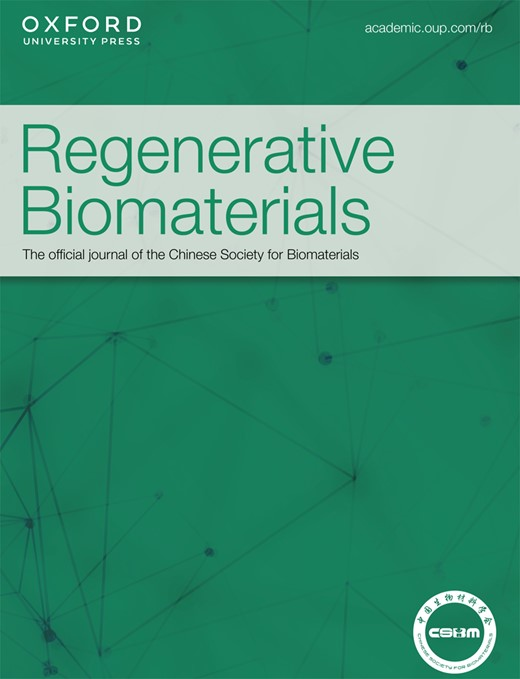NT-3和姜黄素的持续给药增强了用于脊髓损伤修复的脱细胞脊髓基质水凝胶的微环境调节作用
IF 5.6
1区 医学
Q1 MATERIALS SCIENCE, BIOMATERIALS
引用次数: 0
摘要
脱细胞细胞外基质水凝胶,尤其是源自脊髓的脱细胞细胞外基质水凝胶(DSCM 水凝胶),因其在为神经干细胞(NSCs)构建有利于再生的微环境方面的独特特性,已被积极视为重塑原生组织细胞外基质的功能性生物材料。此外,DSCM 水凝胶还能为生长因子和药物提供多个结合域。因此,人们非常希望将外源性神经营养因子和抗炎药物纳入 DSCM 水凝胶,从而协同调节脊髓损伤(SCI)后病变部位的复杂微环境。本文将神经营养素-3(NT-3)和姜黄素(Cur)整合到 DSCM 水凝胶中,用于 SCI 治疗。由于与 DSCM 水凝胶的亲和力不同,NT-3 采用了控制释放的方式,而姜黄素则在最初的 24 小时内爆炸性释放,随后是持续但较缓慢的释放。NT-3和姜黄素的整合能显著促进NSCs的增殖和神经元分化。同时,姜黄素的释放促进了巨噬细胞极化为抗炎亚型,从而进一步促进了 NSCs 向神经元的分化。原位注射的 DSCM+NT3+Cur 水凝胶在缓解大鼠挫伤脊髓的炎症反应方面具有卓越的能力。与单独使用 DSCM 水凝胶相比,DSCM+NT3+Cur 水凝胶能更显著地促进损伤部位的 NSCs 募集及其神经元分化。这些结果有利于功能恢复,后肢运动的改善就是证明。总之,生物活性 DSCM 水凝胶可作为一种多功能载体,协同释放生长因子和药物,对 SCI 后的微环境调节和神经再生大有裨益。本文章由计算机程序翻译,如有差异,请以英文原文为准。
Sustained delivery of NT-3 and curcumin augments microenvironment modulation effects of decellularized spinal cord matrix hydrogel for spinal cord injury repair
Decellularized extracellular matrix hydrogel, especially that derived from spinal cord (DSCM hydrogel), has been actively considered as a functional biomaterial for remodeling the extracellular matrix of the native tissue, due to its unique characteristics in constructing pro-regenerative microenvironment for neural stem cells (NSCs). Furthermore, DSCM hydrogel can provide multiple binding domains to growth factors and drugs. Therefore, both exogenous neurotrophic factors and anti-inflammatory drugs are highly desired to be incorporated into DSCM hydrogel, which may synergistically modulate the complex microenvironment at the lesion site after spinal cord injury (SCI). Herein, neurotrophin-3 (NT-3) and curcumin (Cur) were integrated into DSCM hydrogel for SCI therapy. Due to different affinities to the DSCM hydrogel, NT-3 underwent a controlled release manner, while curcumin released explosively within the first 24 hours, followed by rather sustained but slower release. The integration of both NT-3 and curcumin significantly enhanced NSCs proliferation and their neuronal differentiation. Meanwhile, the release of curcumin promoted macrophages polarization into anti-inflammatory subtypes, which further facilitated NSCs differentiation into neurons. The in-situ injected DSCM+NT3+Cur hydrogel exerted superior capability in alleviating the inflammatory responses in rat contused spinal cord. Compared to DSCM hydrogel alone, DSCM+NT3+Cur hydrogel more significantly promoted the recruitment of NSCs and their neuronal differentiation at the lesion site. These outcomes favored functional recovery, as evidenced by the improved hind limb movement. Overall, the bioactive DSCM hydrogel can serve as a multifunctional carrier for cooperatively release of growth factors and drugs, which significantly benefits microenvironment regulation and nerve regeneration after SCI.
求助全文
通过发布文献求助,成功后即可免费获取论文全文。
去求助
来源期刊

Regenerative Biomaterials
Materials Science-Biomaterials
CiteScore
7.90
自引率
16.40%
发文量
92
审稿时长
10 weeks
期刊介绍:
Regenerative Biomaterials is an international, interdisciplinary, peer-reviewed journal publishing the latest advances in biomaterials and regenerative medicine. The journal provides a forum for the publication of original research papers, reviews, clinical case reports, and commentaries on the topics relevant to the development of advanced regenerative biomaterials concerning novel regenerative technologies and therapeutic approaches for the regeneration and repair of damaged tissues and organs. The interactions of biomaterials with cells and tissue, especially with stem cells, will be of particular focus.
 求助内容:
求助内容: 应助结果提醒方式:
应助结果提醒方式:


